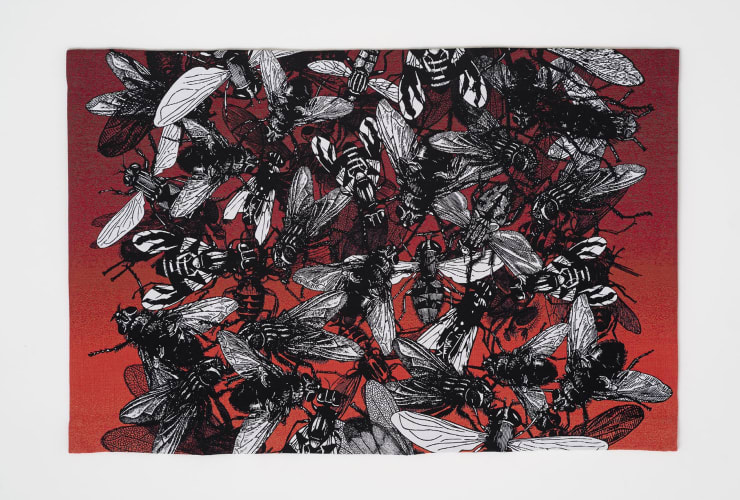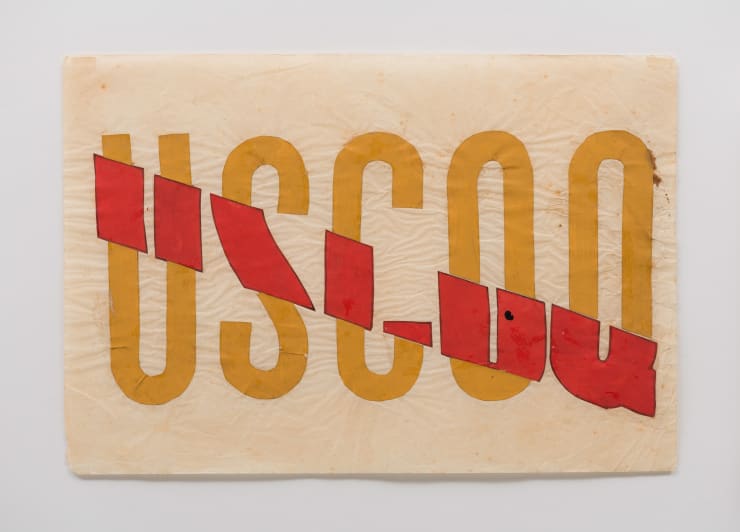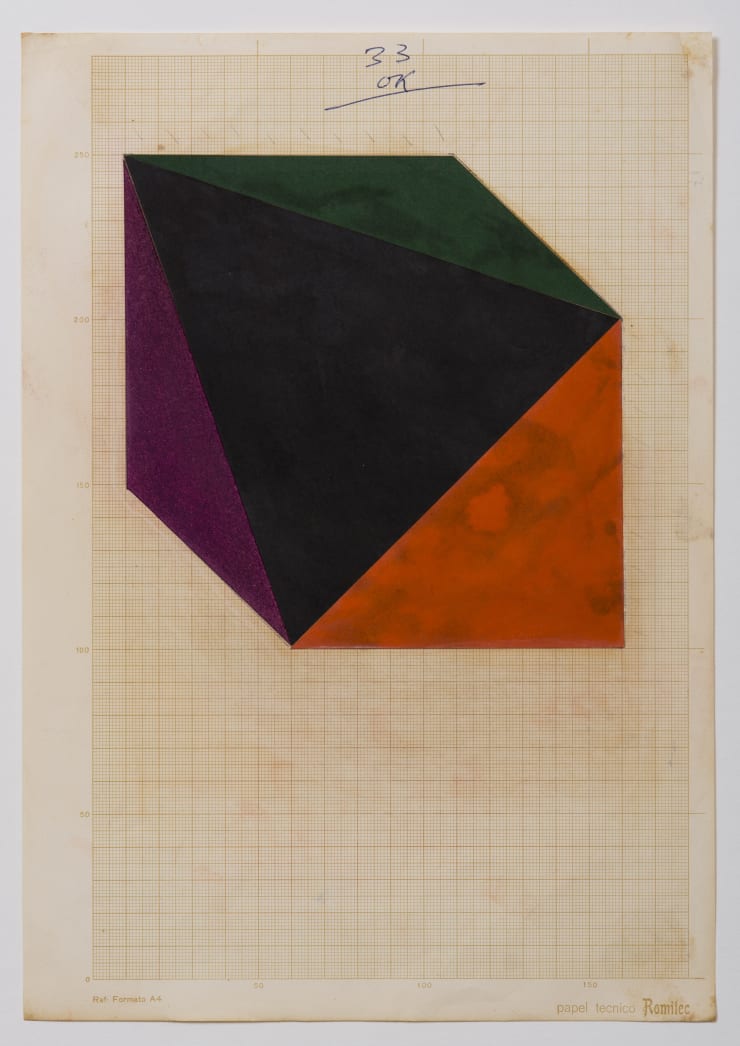-
Booth a09
Bosco sodi | Caio Reisewitz | Geraldo de Barros | héctor zamora
iván navarro | Regina Silveira | Waldemar Cordeiro
-
As a way of recognizing the evolution of artistic research and practice within the contemporary discourse, for this edition of Art Basel Miami Beach, Luciana Brito Galeria is presenting a selection of works that reflects the gallery’s commitment to the artistic debate in a curatorship that considers an intercrossing between different artistic languages and approaches, proper to contemporaneity. To this end, it is presenting a group of works by Waldemar Cordeiro (1925, Italy – 1973, Brazil), in a meaningful dialogue with works by Bosco Sodi (1970, Mexico), Héctor Zamora (1974, Mexico), Iván Navarro (1972, Chile) and Regina Silveira (1932, Brazil). Especially for this edition of the fair, Luciana Brito Galeria is introducing a brand-new partnership with Galeria Estação, reinforcing both galleries’ concern for valorizing art in Brazil as an inclusive and social solution.
-
Regina Silveira
1939, Porto Alegre, Brazil. Lives and works in São Paulo, BrazilRegina Silveira’s artistic research questions the orthodox, preestablished forms of representation, leading her to work with new possibilities of signification. Her works explore the architectural and contextual space, generally evoking a sense of uncanniness through the displacement of the commonplace, that is, our common references. Regina Silveira is known for her research into the principles of perspective, tridimensionality, and the study of shadows, which she employs in large site-specific installations, vinyl cutouts, luminous projections, works in printmaking, embroidery, porcelain, and digital videos.
With a BA in arts from the Instituto de Artes do Rio Grande do Sul (1959), an MA (1980) and PhD in art (1984) from the School of Communication and Arts of the University of São Paulo (ECA USP), her career as a professor includes stints of teaching at the University of Puerto Rico, Mayagüez; at FAAP, São Paulo; and at ECA USP. She was an invited artist at the 1981, 1983 and 1998 editions of the Bienal de São Paulo, the 2013 and 2015 editions of the Bienal Internacional de Curitiba, and the 2001 and 2011 editions of the Bienal do Mercosul. She participated in the Bienal de La Habana, Cuba, in 1986, 1998 and 2015; Mediations Biennale, Poznan, Poland, in 2012; the 6th Taipei Biennial, Taiwan, in 2006; and the 2nd Setouchi Triennale, Japan, in 2016. The artist’s work has been presented at Paço das Artes, São Paulo, 2020; the Museu Brasileiro da Escultura (MuBE), São Paulo, 2018; the Museu Oscar Niemeyer, Curitiba, 2015; the Museo Amparo, Puebla, Mexico, 2014; the Fundação Iberê Camargo, Porto Alegre, 2011; Atlas Sztuki Gallery, Lodz, Poland, 2010; Masp, 2010; and the Museo Nacional Centro de Arte Reina Sofía, Madrid, Spain, 2005. Regina Silveira was awarded the Prêmio Masp (2013), the Prêmio APCA for her career (2011), and the Prêmio Fundação Bunge (2009). She has received grants from the Fulbright (1994), Pollock-Krasner (1993) and Guggenheim (1990) foundations, and her work figures in countless public and private collections, such as those of the Cisneros-Fontanals Art Foundation (USA), Inhotim, Coleção Itaú, El Museo del Barrio (USA), MAC-USP, Masp, MAM-RJ/SP, the Pinacoteca de São Paulo, MoMA (USA), and the Phoenix Museum (USA).
-
Héctor Zamora
1974, Mexico City, Mexico. Lives and works in Lisbon, PortugalHéctor Zamora is better known for his research, which involves public spaces and the built environment. In his works, the artist reinvents and redefines conventional spaces – exhibition spaces or others – giving rise to noise between the meanings of public and private, exterior and interior, real and imaginary. If, on the one hand, Héctor Zamora’s work deals with the aesthetic and formal legacy of concretism and other Latin American vanguard movements, on the other, it problematizes social and political questions related to work in a consumer society and to the subversion of architectures, of the city, and of history.
Héctor Zamora holds a degree in graphic design and structural geometry. He has held solo shows at prominent institutions which include The Roof Garden Commission, MET NY, USA (2020); LABOR, Mexico City (2019); Pavilhão Branco (Portugal, 2018); the Museo de Arte Contemporáneo de Monterrey (Mexico, 2017); Fundación RAC (Spain, 2017); the Palais de Tokyo (Spain, 2016); CCBB São Paulo (2016), the Center for Contemporary Art (Los Angeles, USA, 2013) and Itaú Cultural (São Paulo, 2010). He has participated in group shows at venues that include the 4th Mediterranean Biennial, Israel (2021); Hirshhorn Museum, USA (2020); the Centro Galego de Arte Contemporánea, Spain (2018); the 12th Shanghai Biennale, China (2018); MAM-RJ (2014); Guggenheim Museum (USA, 2013); the Museo de Arte de Lima (Peru, 2012); the 54th Venice Biennale (Italy, 2011); the 11th and 14th editions of the Biennale de Lyon (2011 and 2017); the 12th International Cairo Biennale (Egypt, 2010); the 9th and 12th editions of the Bienal de la Habana (2006 and 2015); and the 27th Bienal de São Paulo (2006). Héctor Zamora has moreover been awarded prizes from the Graham Foundation Arquitetura + Arte (2011), the Garage Centre for Contemporary Culture (2009), the Pollock-Krasner Foundation (2007), the Cisneros Fontanals Art Foundation (2006), the Jumex Collection Foundation (2006), and others. His works figure in collections of important institutions such as Amparo Museum (Mexico), Fundación RAC (Spain), and Hirshhorn Museum and Sculpture Garden (USA).
-
Waldemar Cordeiro
1925, Rome, Italy - 1973, São Paulo, BrazilWaldemar Cordeiro was a key figure in the development of concrete art, a vanguard movement essential for the transition of modern art to contemporary art, which came to define 20th-century Brazilian art. Besides being a pioneer in computer art as early as the 1960s, Waldemar Cordeiro developed and implemented important landscaping designs in Brazil. In his interdisciplinary research he defended painting in its essence, with self-supporting basic colors and lines, without the backing of figurative representation. He was notable for his objective and rational art, very much associated to his theoretical studies, as well as for his investigation of industrial materials and elements. Cordeiro worked for an art accessible to all, seeking a collective sense that was also aligned with technology, to design and to landscaping. His research in art was always coupled with a social and political concern.
Waldemar Cordeiro studied at the Academy of Fine Arts of Rome (1938) and at the Tasso Lyceum of Rome (1945). In 1949, he took up residence in Brazil. He participated in the inaugural show of the Museu de Arte Moderna of São Paulo (MAM-SP), Do figurativismo ao abstracionismo (1949), and in the 1st Bienal de São Paulo (1951). He was also one of the organizers of the show Ruptura, also at MAM-SP (1952), and of Arteônica, at Fundação Armando Alvares Penteado, FAAP-SP (1971). Solo shows of his work have been held at noteworthy venues, including MAM-RJ/SP, CCSP, Buffalo University (USA), MAC-SP, Itaú Cultural, São Paulo, and the Paço Imperial, Rio de Janeiro. Group shows featuring his work have been held at important venues which include the Walker Art Center (USA), the Pinacoteca de São Paulo, the Museum of Fine Arts Houston (USA), the Museum of Modern Art (MoMA), New York (USA), CCBB-SP/RJ, Goethe-Institut, New York (USA), the Museo Nacional Centro de Arte Reina Sofía, Madrid (Spain), Instituto Tomie Ohtake, São Paulo, the Bienal de São Paulo (2012, 1975, 1973, 1969, 1967, 1965, 1963, 1961, 1959, 1957, 1955, 1953 and 1951), and the Biennial of Nuremberg (Germany). Waldemar Cordeiro’s works figure in many prominent collections, including those of the Cisneros Fontanals Art Foundation (USA), the Museu de Arte Contemporânea of the University of São Paulo, the Patricia Phelps de Cisneros Collection (USA), the Pinacoteca de São Paulo, the Museum of Modern Art (MoMA) of New York (USA), the Museum of Fine Arts, Houston (USA), and ZKM Museum (Germany).
-
Bosco Sodi
1970, Mexico City, Mexico. Lives and works between New York, USA, and Mexico City, MexicoBosco Sodi’s research is outstanding for its simplicity of materials from a natural origin, such as pigments, sawdust, fibers, wood, soil, etc. The combination of these elements with the gesturality of his production makes each work unique, while creating a special connection between the artist and his process of creation, which transcends the conceptual. Currently, he has been making increasing use of techniques from olden times, which not only establish a direct relationship with the ethnobotanical discourse, but also recover his native Latin American ancestrality. Bosco Sodi also associates these techniques to traditional and contemporary processes, dialoguing with the movements of land art and informalism.
He has presented solo shows at prominent institutions that include the University of South Florida Contemporary Art Museum, Tampa, USA (2021); CAC Málaga, Spain (2020); the Royal Society of Sculptors, London, England (2019); the Museo di Scultura Antica Giovanni Barracco, Rome, Italy (2019); the Mexican Cultural Institute, Washington, DC, USA (2019); the Museo Nacional de Arte, Mexico (2017); and the Bronx Museum, New York, USA (2010). He has participated in group shows at venues that include the Harbour Arts Sculpture Park, Hong Kong (2018); the Museum of Modern Art, Gunma, Japan (2017) and the Museo Espacio, Mexico (2016). Bosco Sodi’s work is also part of important collections such as Colección JUMEX (Mexico), the Harvard Art Museums (USA), the Museum of Contemporary Art San Diego (USA), the New Orleans Museum of Art (USA), the Scottish National Gallery of Art (Scotland), and Walker Art Center (USA).
-
Iván Navarro
1972, Santiago, Chile. Lives and works in New York, USAThe appeal of Iván Navarro’s works springs from a combination of elements that question our perception. On the one hand, from a formalist point of view, his works are carefully constructed, having light as their main support. Light that arouses feelings, at the same time that it sparks enchantment in the spectator. Iván Navarro’s production is also imbued with political connotations, communicated to the public through countless strategies, as seen in the titles of his works, in his careful use of color, in the use of anagrams, or in the appropriation and deconstruction of symbols that represent ideologies and institutionalized power.
Iván Navarro graduated in visual arts, in Santiago, Chile, in 1995. He has held solo shows at prominent institutions such as Farol Santander, São Paulo (2020); MAC – Niterói, RJ (2019); MACBA, Buenos Aires, Argentina (2019); the Museu Nacional de Belas Artes, Santiago, Chile (2015); and the Espace Culturel Louis Vuitton, Paris, France (2010). Titles and venues of group shows he has participated in most notably include the Illuminate SF Festival of Light, São Francisco, USA (2020); the XIV Bienal de Nuevos Medios, Museo Nacional de Bellas Artes, Santiago, Chile (2019); the 13th Biennale of Cairo, Egypt (2019); MACBA, Buenos Aires, Argentina (2018); Guggenheim NY, USA (2018); the Museo del Barrio, NY, USA (2017); MuBE-SP (2016); the Centro Nacional de Arte Contemporáneo, Santiago, Chile (2016); the 10th Bienal do Mercosul, Porto Alegre (2015); the Cairo International Biennale, Egypt (2010); the 53rd Biennale di Venezia, Italy (2009); and the 2nd Moscow Biennale, Russia (2007). His works figure in the collections of important institutions such as the Centro Galego de Arte Contemporánea (Spain), the Fonds National d’Art Contemporain (France), the Hirshhorn Museum and Sculpture Garden (USA), Inhotim, the Museum of Fine Arts (Boston, USA), the Saatchi Collection (England) and the Solomon R. Guggenheim Museum (USA).
-
Caio Reisewitz
1967, São Paulo, Brazil. Lives and works in São Paulo, BrazilCaio Reisewitz’s research takes photography as its main medium. Through technical and thematic refinement, his work evinces an interest in human action and its social and political effects, whether in the natural space or the architectural space. While his photographic technique highlights the dramaticity among shapes, colors and textures, his artistic poetics constructs a nearly dreamlike aesthetic repertoire. These aspects establish a dichotomous dialogue between the real (that which is characteristic of the photographic record) and the chimerical (our own repertoires).
With a degree in visual arts from Mainz University (Germany), Caio Reisewitz has an advanced degree in visual poetics and an MA from the University of São Paulo. The biennials he has participated in include: the 26th Bienal de São Paulo (2004), the 51st Biennale di Venezia (2005), in Italy, and the Nanjing Biennale (2010), in China. His work has also been shown at the Museo de Arte Contemporáneo de Castilla y León (MUSAC) (2010, Spain); Instituto Moreira Salles, Rio de Janeiro and São Paulo (2010); the Ella Fontanals-Cisneros Collection Miami (2005, 2010, USA); the International Center of Photography (ICP), New York (2014, USA); the Maison Européenne de la Photographie, Paris (2015, France); the Pinacoteca de São Paulo (2017), as well as at Photo Shanghai (2019, China). In 2020, he released the book Altamira, based on a collection of the same name acquired by the Pinacoteca de São Paulo. His work figures in important collections such as those of the Cisneros Fontanals Art Foundation (USA); the Fundación ARCO Madrid (Spain); the Collezione Fondazione Giovanni Guastalla (Italy); the Fond National d’Art Contemporain (France); MUSAC (Spain); the Museu de Arte Moderna (MAM) of São Paulo, of Rio de Janeiro and of Salvador (Brazil); the Musée Malraux (France); and the Pinacoteca de São Paulo.
-
Geraldo de Barros
1923, Chavantes, SP – 1998, São PauloGeraldo de Barros is a key name of 20th-century Brazilian art. Combining his first studies on painting with a later interest in photography, he pushed the envelope of the traditional photographic processes, questioning the classic rules of composition. Geraldo de Barros took a formal concern – as clearly seen in Brazilian concretism, in which participated intensely – and managed to merge this with his social concerns, leading him to approach the industrial processes in his work, dealing coherently with geometric constructions, reproducibility, the socialization of art, the theory of form and industrial design.
At the age of 26, Geraldo de Barros participated in the creation of the photography course and darkroom at the Museu de Arte de São Paulo (Masp), where he presented the exhibition Fotoformas, in 1950. The artist was also one of the most active members of the Foto Cine Clube Bandeirante, which marked the experimentation of photography in Brazil. In 1951, he participated in the Hochschule für Gestaltung (HfG – School of Design) in Ulm, Germany. He was also one of the founders of Grupo Ruptura (1952) and of Grupo Rex (1966), and participated in the 1st, 2nd, 9th, 15th and 21st editions of the Bienal de São Paulo, and in the 1986 Venice Biennale (Italy). Geraldo de Barros’s works have participated posthumously in various national and international exhibitions. In 2014, Instituto Moreira Salles, in Rio de Janeiro, organized a retrospective of the artist, and in the following year the same exhibition was held at Sesc Belenzinho, in São Paulo. In 2017, the Fundação Arpad Szenes-Vieira da Silva in Lisbon (Portugal) and the Document Gallery, in Chicago (USA), held solo shows featuring works by the artist, followed by others at Side Gallery, in Barcelona (Spain), in 2018, and Kunst- und Kulturstiftung Opelvillen, in Rüsselsheim (Germany), in 2019. His work figures in important collections such as those of the Fundação de Arte Cisneros Fontanals, the Art Fund of the State of Geneva, the Fundação Bienal de São Paulo, Instituto Inhotim, the Ludwig Museum, the Max Bill Foundation, the Max Art Museum, the Museu de Arte Contemporânea of São Paulo, the Museu de Arte Moderna of São Paulo, the Museu de Belas Artes, the Museu de Arte de São Paulo, MoMA, Tate Modern, Photographer’s Gallery, the Pinacoteca de São Paulo, the Museo de Arte Latinoamericano de Buenos Aires, and others.
-
Art Basel Miami Beach 2021 : English
Past viewing_room


















